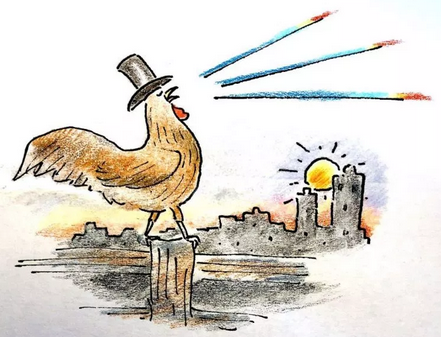In 1972 or 1973, several years before my work was first accepted into The New Yorker, I began drawing in the black sketchbooks you see above. At the time it seemed like a good idea, and it remained a good idea until the late 1970s, when having arrived at Sketchbook #73 (yes, I numbered them), I suddenly stopped. The reason for stopping was simple. I was no longer drawing the way I’d drawn for the past eight or so years.
The sketchbooks are not filled with what most would call sketches — they are filled (predominantly) with cartoons, usually captioned — and as finished as I thought they should be. Those pre-New Yorker drawings were not worked on — I just drew them from scratch right onto the sketchbook pages. If I did something I hated, I’d rip out the page.
Above: it was rare to draw in a small sketchbook, but it happened when I came to sketchbook #53, (February 20, 1978)… the caption: “Do you think he’d like a stick of Dentine?”; below is sketchbook #73 (August 1979) a titled drawing: Mr. Geng Has Coconuts In The Pool Problems
In the years I drew in the books, I would go to my local copier place and turn my most recent sketchbook over to the copy person. The drawings to be copied out of the book were marked off. Those drawings were my weekly batch. For some reason I decided to take each copy, cut it down to less than 8 1/2″ x 11″ and rubber cement it on to thin illustration board. Then I’d take the pile of mounted cartoons uptown to The New Yorker. No one asked me to do this, or suggested I do it — it was a time wasting system I developed all on my own. I’ve put those mounted drawings in trash cans; the plan is to burn them some day. The rubber cement has turned the drawings dark brown.
In 1977, when I got my foot in the door at The New Yorker, my output (for lack of a better word) increased. I no longer had the patience to do a completed drawing on each sketchbook page. Instead of drawing in the sketchbook, I began drawing on copy paper. I bought reams of copy paper, and eventually cases of copy paper (my Rapidograph loves copy paper). Bits and pieces of drawings and sentence fragments, or just a word or two, now make it onto paper until the cartoon gods decide to show me the way. When that happens, a drawing is swiftly put down on paper — much like the old sketchbook days.
I’ve not shown all the sketchbooks I worked in. Some were given away over the years, and a few are somewhere in the Spill archives waiting to be found (for instance, books #1 -10 are not shown. Years ago I placed them someplace “special” and of course have no idea now where that special place is).
When the sketchbook “system(?)” ended I began placing work in manilla folders marked by month and year. Each folder contained a month’s work — actual work pages, not finished drawings. That system ended a few years back when I ran out of manilla folders and didn’t want to bother buying more. So I began just piling up the work sheets. The finished drawings (i.e., the rejected work) are in their own piles, awaiting who knows what fate. The published drawings are in their own piles. Things sure have become complicated.
_____________________________________________________________________
Today’s Daily Cartoonist & Cartoon
 Jon Adams on working from home.
Jon Adams on working from home.
Mr. Adams began contributing his work to The New Yorker in October of 2017. Visit his website here.


